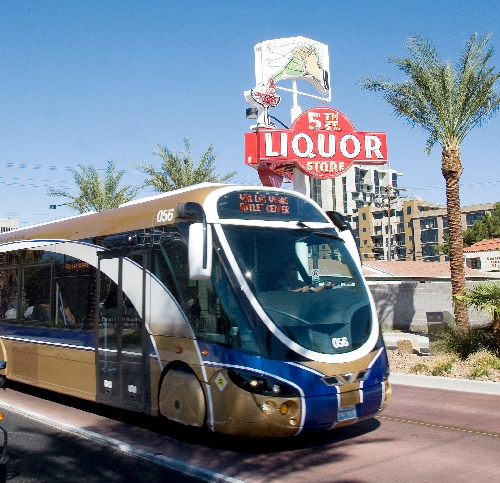Bus riders adjust to express route switcheroo

The name is gone and, in some cases, so are the vehicles featured in the marketing blitz to lure Las Vegans into taking public transportation.
All of this in a matter of months.
It’s difficult to figure out what to make of the Regional Transportation Commission’s first aggressive push for mass transit, a 15-mile express route from Centennial Hills to downtown Las Vegas.
Can we label the line once known as ACExpress a success even if it didn’t appear to be as advertised? Even if passengers ended up riding buses as often as the much-touted sleek light-rail copycat vehicle?
Some Centennial Hills dwellers were disgusted enough to give up on the inaugural express route and return to their own vehicles after buses began pulling into the fancy park-and-ride two weeks after it opened.
“This bus bounced along and creaked like it was traversing a Peruvian Peak,” Michael Sommermeyer, a court administrator, wrote on his blog soon after the line was introduced. “We bounced and shouted at each other to try and talk above the din.”
That account sounds a bit different from what commission General Manager Jacob Snow declared as the modern express line street car vehicles were unveiled in March: “This is not your grandfather’s bus.”
Despite the vehicle switcheroo, the C-line appears to be a hit with many attracted to the nonstop ride downtown.
In April, 18,210 passengers boarded the express bus; in May the route had 17,935 riders; in June ridership jumped to 19,784, and in July the Transportation Commission counted 19,677 passengers.
The figures leave no doubt the new route has taken vehicles off the road.
With the Nevada Department of Transportation beginning its two-year widening project on U.S. Highway 95 between Washington Avenue and Ann Road, Tracy Bower, a spokeswoman for the transit agency, is confident more motorists will give the Centennial express line a go.
“As the construction project on U.S. 95 gets under way, we think people will look for ways to avoid the congestion.”
Bower might be on to something because look who’s back.
“I went back to it this week,” Sommermeyer said. “Here’s the deal. I lived through the expansion of 95 a few years back. The other day the drive that took 20 minutes took 40 minutes. I’m not going to get high blood pressure over the drive to work.”
And, how did it go?
“There’s a marked difference between a bus and the ACE. The ACE is really like riding a train, but it wasn’t that bad,” said Sommermeyer, who last week rode a natural gas bus four times and the light-rail looking thingy once.
“My problem was I felt I got ripped off the first time because you’re sold on the notion you’re going to ride on this fast sleek bus that looks like it flew in from the future and end up riding in a tin can. The ones this week weren’t bad, and it’s better than stewing over someone cutting you off.”
Next up is the park-and-ride facility on Westcliff and Durango drives. This new building set to open in November will be home to several routes, including a second express line to downtown. It will connect to the downtown Bonneville Transit Center, which will open in early November.
The marketing scheme for the Westcliff facility varies from the Centennial Hills strategy. The Regional Transportation Commission tells potential passengers upfront that vehicles servicing the station will be compressed natural gas coaches, which look like the traditional gold bus.
The commission spent about $165 million on the 50 high-speed-rail-like vehicles and bus shelters presented when the express lines were introduced. But Bower said the extravagant coaches were never meant to be solely for the express lines. She said the public might have thought that because the unique look captured attention during the introduction of the new system.
That seems like an odd explanation, given that the sleek vehicle was the only one ever pictured or mentioned in all the agency’s literature and media packets about the express route. It was never a question that the state-of-the-art design was clearly a key component in the commission’s effort to do away with the stigma attached to riding public transportation and convince white-collar workers to ditch their cars.
Personally, I have a gut feeling that something is not right with the light-rail-like buses. They may not be functioning as well as expected. Just a guess, not only because of the change in vehicles, but also because several readers have seen the newer rides broken down on the freeway numerous times.
But perhaps the transit agency has learned a few things and adjusted their system accordingly.
For one, the vehicle once known as the ACE is more efficient for routes such as the Strip and the Green Line, which will provide service from Boulder Highway to downtown and east to Henderson.
These routes have more stops and for this vehicle, an electric-diesel hybrid, that is beneficial because it allows them to recharge.
The natural gas-fueled buses are more efficient on longer runs with fewer stops such as the express routes, Bower said.
We all thought that the ACExpress lines meant the RTC would be using the ACE vehicles, the sleek shiny ones we were told not to call buses. Now that we know that’s not the case, perhaps the ACE Cab company did the commission a favor by clearing up the confusion when it sued the transit agency over the name of their express route.
The commission spent $70,000 removing ACE from shelters, signs and buses.
Now it’s simply called the express route, which it is no matter what type of vehicle you draw.
If you have a question, tip or tirade, call Adrienne Packer at 702-387-2904, or send an e-mail to roadwarrior@reviewjournal
.com. Please include your phone number.